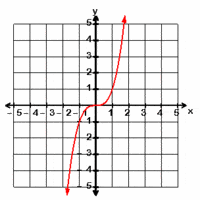
End Behaviors of Polynomials
Quiz
•
Mathematics
•
11th Grade
•
Hard
Standards-aligned

Anthony Clark
FREE Resource
20 questions
Show all answers
1.
MULTIPLE CHOICE QUESTION
1 min • 1 pt
Determine the end behavior of the polynomial by identifying the degree and leading coefficient.
f(x) = 5x4 - x + 6
UP-UP
UP-DOWN
DOWN-UP
DOWN-DOWN
2.
MULTIPLE CHOICE QUESTION
1 min • 1 pt
The degree and the sign of the leading coefficient (positive or negative) of a polynomial determines the behavior of the ends for the graph.
Enter the polynomial function into a graphing calculator or online graphing tool to determine the end behavior.
f(x) = -x5 - 4x +2
Left up Right up
Left up Right down
Left down Right up
Left down Right down
3.
MULTIPLE CHOICE QUESTION
1 min • 1 pt

The end behavior of a polynomial function is determined by the degree and the sign of the leading coefficient.
Identify the degree of the polynomial and the sign of the leading coefficient
Leading Coefficient Positive
Degree - Even
Leading Coefficient Positive
Degree - Odd
Leading Coefficient Negative
Degree - Even
Leading Coefficient Negative
Degree - Odd
4.
MULTIPLE CHOICE QUESTION
1 min • 1 pt
The degree and the sign of the leading coefficient (positive or negative) of a polynomial determines the behavior of the ends for the graph.
Enter the polynomial function into a graphing calculator or online graphing tool to determine the end behavior.
f(x) = -2x2 + 3x
Left up Right up
Left up Right down
Left down Right up
Left down Right down
5.
MULTIPLE CHOICE QUESTION
1 min • 1 pt

What is the end behavior of this polynomial?
6.
MULTIPLE CHOICE QUESTION
1 min • 5 pts

Is the leading coefficient positive or negative? Why?
The leading coefficient is POSITIVE because the RIGHT SIDE goes UP.
The leading coefficient is NEGATIVE because the RIGHT SIDE goes UP.
The leading coefficient is POSITIVE because the RIGHT SIDE goes DOWN.
The leading coefficient is NEGATIVE because the RIGHT SIDE goes DOWN.
7.
MULTIPLE CHOICE QUESTION
1 min • 1 pt

Describe the end behavior of the graph.
x → -∞, f(x) → ∞ and x→∞, f(x) →⁻∞
x → -∞, f(x) → ∞ and x→∞, f(x) →∞
x → -∞, f(x) → ∞ and x→∞, f(x) → 0
x → -∞,f(x) → -∞and x→ ∞, f(x) → ∞
Create a free account and access millions of resources
Similar Resources on Wayground

15 questions
Polynomial End and Local Behavior
Quiz
•
9th - 12th Grade

20 questions
Polynomial Function End Behavior
Quiz
•
9th - 12th Grade

21 questions
Topic 7.1.1: Classifying Polynomials Practice
Quiz
•
9th - 12th Grade

15 questions
End Behavior Practice
Quiz
•
11th Grade

20 questions
Identifying the Degree and Leading Coefficients of Polynomials
Quiz
•
9th Grade - University

16 questions
Evaluating Polynomials and End-Behavior
Quiz
•
9th - 12th Grade

16 questions
Identifying the Degree and Leading Coefficients of Polynomials
Quiz
•
9th - 12th Grade

20 questions
Polynomial and End Behavior
Quiz
•
11th Grade - University
Popular Resources on Wayground

10 questions
Lab Safety Procedures and Guidelines
Interactive video
•
6th - 10th Grade

10 questions
Nouns, nouns, nouns
Quiz
•
3rd Grade

10 questions
9/11 Experience and Reflections
Interactive video
•
10th - 12th Grade

25 questions
Multiplication Facts
Quiz
•
5th Grade

11 questions
All about me
Quiz
•
Professional Development

22 questions
Adding Integers
Quiz
•
6th Grade

15 questions
Subtracting Integers
Quiz
•
7th Grade

9 questions
Tips & Tricks
Lesson
•
6th - 8th Grade
Discover more resources for Mathematics

20 questions
Multi-Step Equations and Variables on Both Sides
Quiz
•
9th - 12th Grade

12 questions
PCTI Stem Academy Gradebook Review
Lesson
•
9th - 12th Grade

20 questions
Points, Lines & Planes
Quiz
•
9th - 11th Grade

20 questions
Week 4 Memory Builder 1 (Squares and Roots) Term 1
Quiz
•
9th - 12th Grade

20 questions
Solve One and Two Step Equations
Quiz
•
9th - 11th Grade

16 questions
Positive vs Negative Intervals
Quiz
•
9th - 12th Grade

20 questions
Solving Absolute Value Equations
Quiz
•
11th - 12th Grade

17 questions
Identify Geometric Concepts and Relationships
Quiz
•
9th - 12th Grade


